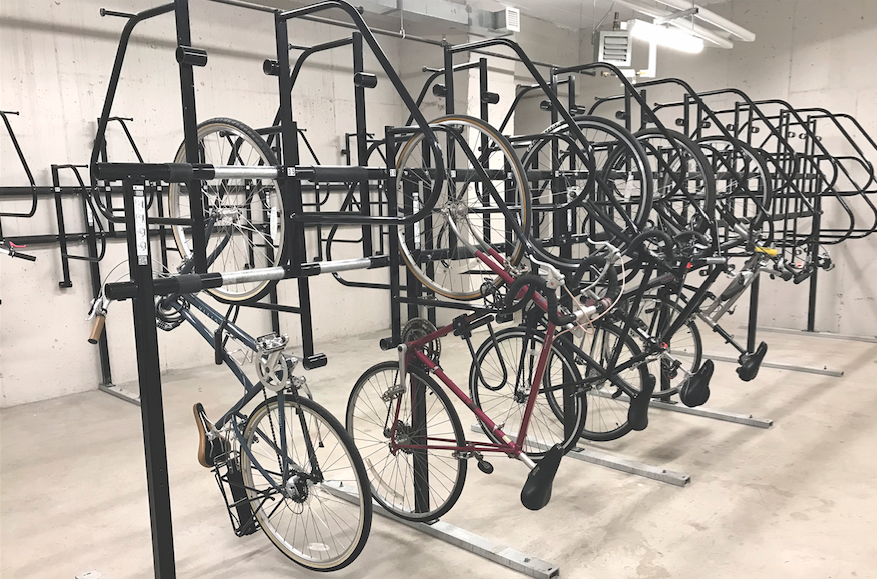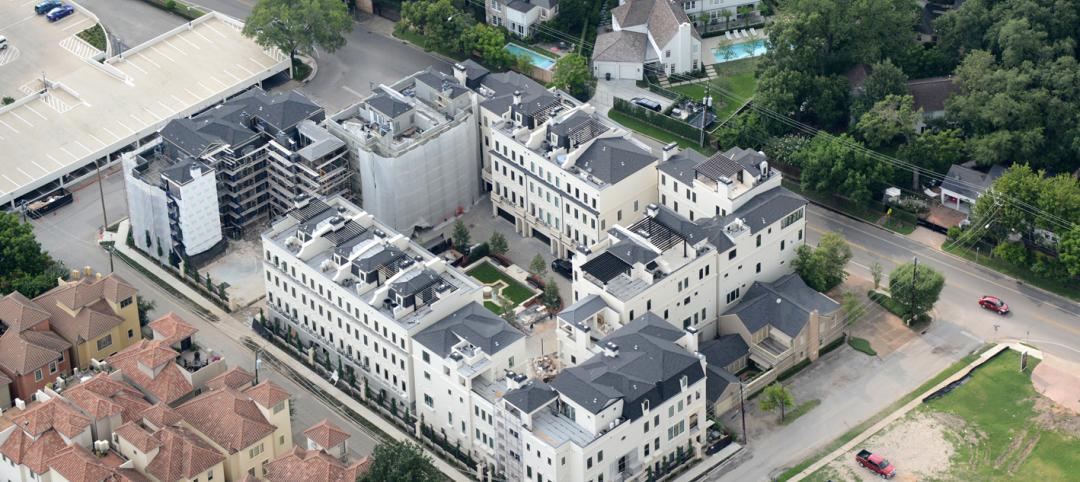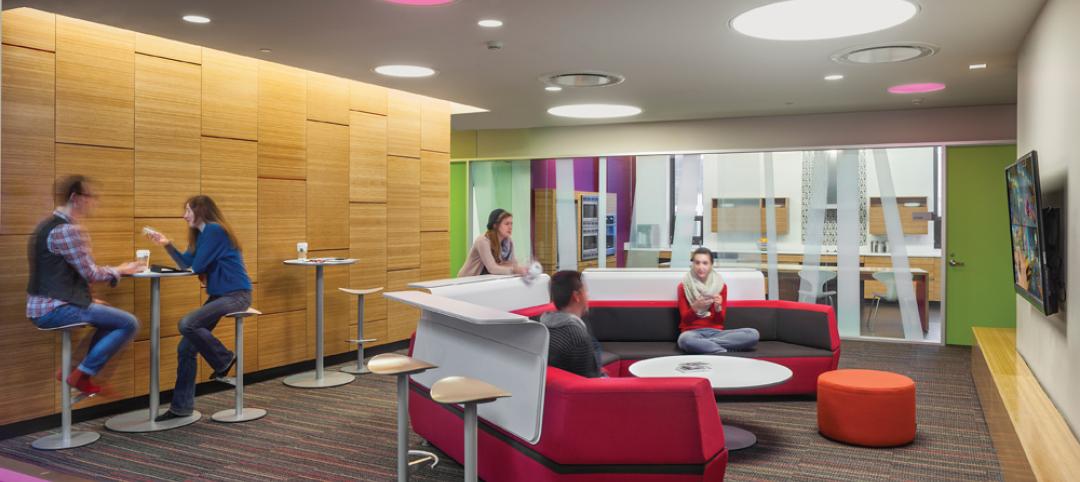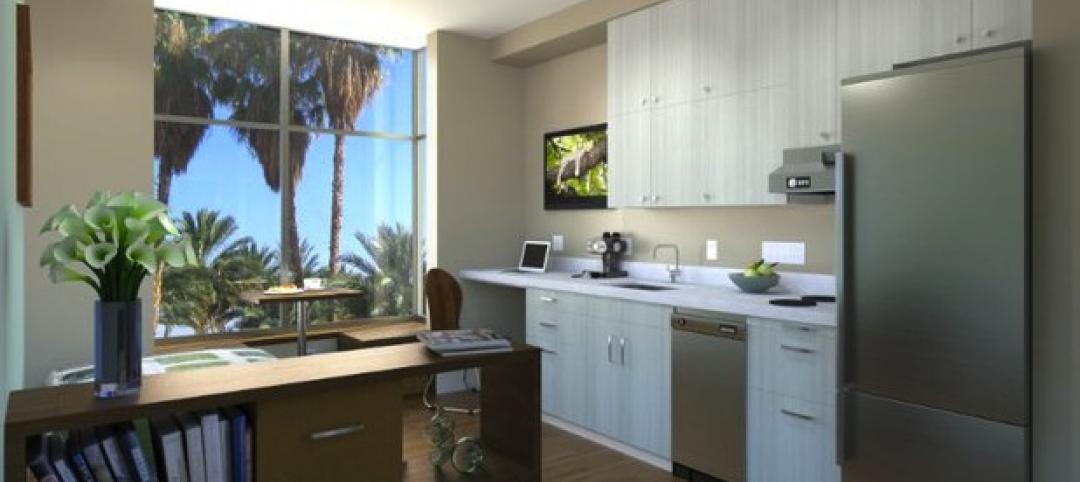Bicycling has become a preferred means of environmentally friendly, fun, and healthy transportation for millions of America’s apartment, condo, and townhouse dwellers.
From 2008 to 2017, bicycle ridership in the U.S. grew 40%, from 47 million to 66 million, according to Statistica.com. Couple the dramatic increase in cyclists with the fact that U.S. households are renting at higher rates than at any time in the past 50 years, and multifamily developers and their project teams are left with no choice but to include bicycle storage and maintenance high on their list of amenities.
In fact, this publication’s exclusive Multifamily Amenities 2017 survey (https://bit.ly/2eZMluw) found that two-thirds of respondents (66.5%) had included “secure bicycle storage” in recent projects.

A multifamily project designed by Denver architectural firm Kephart features a bicycle kitchen with an easily accessible wash station, work table, and workbench with tools for repairs and maintenance. Photo: Kephart
“Every project we design has bike storage of some type, whether it is standard racks on the street, individual private lockers, or hundreds of bikes stored in a stacker configuration in the parking garage,” said Nathan Sciarra, AIA, Associate Principal, KTGY Architecture + Planning, Denver.
Bicycle amenity spaces can be divided into three distinct types: storage only (bike parking, storage racks); bike storage with workshop space (pumps, basic tools, wash area); and the latest variant, bicycle kitchens (more intensive workshop areas combined with an added social element).
A bicycle kitchen is a luxury amenity that is very appealing to a growing group of multifamily dwellers. “I would describe them as bicycle clubhouses, where like-minded residents mingle, collaborate, share stories and adventures, and create connections,” said Bobby Long, Principal, Kephart. Considerable thought needs to go into the aesthetics and comfort of bicycle kitchens.
According to the design experts we consulted, there are certain features no bicycle kitchen should be without: large-screen TVs with cable service, WiFi, comfortable furniture that encourages gathering and relaxation, good lighting, and bicycle-themed artwork that brands the space. (One even has a sculpture made from bicycle parts.) No self-respecting cyclist wants to hang out in a poorly lit, uninviting, eldritch space reminiscent of the local auto shop.
Storage and workshop aspects cannot be ignored. Space for tools and repair equipment, storage racks with ample clearance for loading and unloading onto cars, accessory storage for helmets and bags, and an area for washing bikes must be accounted for.
Creating the perfect bicycle kitchen is all about finding the ideal balance between a workshop and a social space, said Jimmy Sinis, Senior Design Manager and Senior Associate, Stantec.
“Spaces like this foster a sense of community among residents,” said KTGY’s Sciarra. “To be considered a full bicycle kitchen, the design must incorporate comfortable seating, entertainment opportunities, and more. Then it’s more a kitchen than a repair space.”
Not every multifamily project needs a full bicycle kitchen, but bicycle storage of some kind has become a necessity for most new apartment and condo enterprises.
RATIOS, RATIOS, IT’S ALL ABOUT THE RATIOS
Then there are those pesky zoning requirements and resident-to-space ratios to consider. Having too little—or even too much—room can impair the functionality of bicycle storage areas.
In some jurisdictions, local zoning law dictates the required ratio of bike storage spaces to apartment units. Washington, D.C., requires one bike parking space for every three residential units (the same as LEED). Some designers feel that’s not enough bike storage space to meet residents’ expectations.
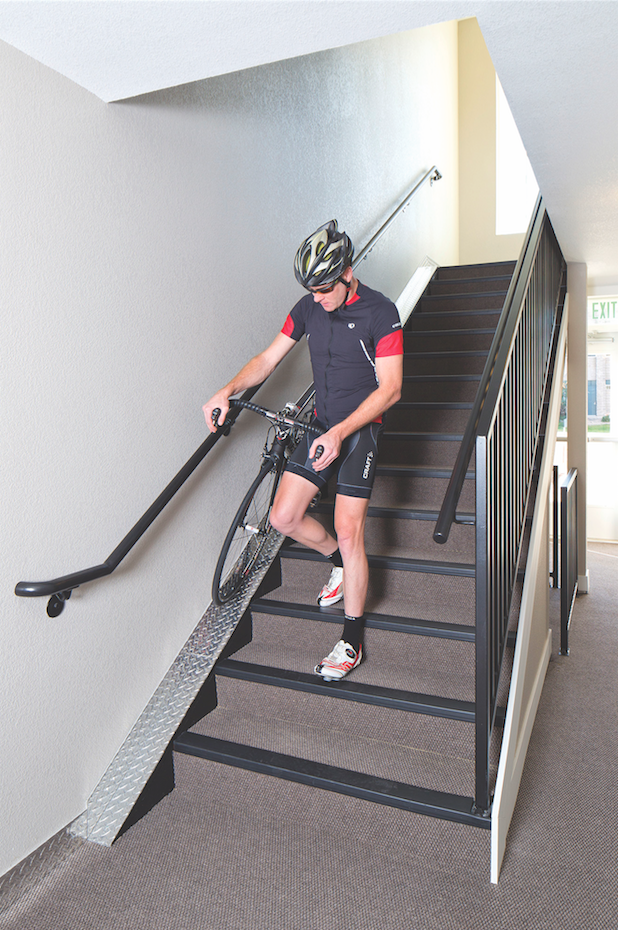
A metal ramp in a Boulder View (Colo.) community designed by KTGY Architecture + Planning runs along the edge of the stairs for easier shifting of bikes between floors. Photo: KTGY Architecture + Planning
According to Sciarra, the ideal ratio depends a lot on where the project is located. In urban areas with easy access to stores, restaurants, and entertainment venues, one bicycle space for every two units should work. (According to Ira Mitchneck, AIA, Senior Associate, New York–based Dattner Architects has found this ratio to work just fine in its projects, which are primarily in dense urban areas.) In suburban locations where more residents probably have a car, the ratio can be lowered to one storage space for every four or five units, said Sciarra.
Determining the best ratio of bike storage spaces to automobile parking spaces is more complicated. Miami’s zoning code, known as Miami 21, is a form-based system that relies on New Urbanism and Smart Buildings principles. It requires one bike storage space for every 20 parking spaces. Other jurisdictions allow for fewer vehicle parking spaces as the number of bike storage spaces increases.
“We don’t believe the correlation is that simple,” Sciarra said. “In our experience, the number of parking spaces and bike storage is driven more by location and the bike culture of that location.”
Kephart’s Long agrees. “I don’t think we’re looking at any specific ratios,” he said. “Each project is so specific, based on adjacency to bike lanes and paths and the specific bike culture.” Meaning whether—and how much—residents use their bikes for commuting, shopping, recreation, and physical training. “It’s certainly not a one-size-fits-all approach,” said Long.
Related Stories
| Jan 2, 2015
Construction put in place enjoyed healthy gains in 2014
Construction consultant FMI foresees—with some caveats—continuing growth in the office, lodging, and manufacturing sectors. But funding uncertainties raise red flags in education and healthcare.
Sponsored | | Dec 30, 2014
Case studies: Engineered wood brings cost savings, design flexibility across commercial project types
For commercial architects facing increasing pressure to design innovative structures while simultaneously cutting costs and accommodating tight deadlines, engineered wood systems are providing a welcome solution.
| Dec 28, 2014
Robots, drones, and printed buildings: The promise of automated construction
Building Teams across the globe are employing advanced robotics to simplify what is inherently a complex, messy process—construction.
| Dec 28, 2014
AIA course: Enhancing interior comfort while improving overall building efficacy
Providing more comfortable conditions to building occupants has become a top priority in today’s interior designs. This course is worth 1.0 AIA LU/HSW.
| Dec 28, 2014
6 trends steering today's college residence halls
University students want more in a residence hall than just a place to sleep. They want a space that reflects their style of living and learning.
| Dec 22, 2014
Studio Gang to design Chicago’s third-tallest skyscraper
The first U.S. real-estate investment by The Wanda Group, owned by China’s richest man, will be an 88-story, 1,148-ft-tall mixed-use tower designed by Jeanne Gang.
| Dec 17, 2014
ULI report looks at growing appeal of micro unit apartments
New research from the Urban Land Institute suggests that micro units have staying power as a housing type that appeals to urban dwellers in high-cost markets who are willing to trade space for improved affordability and proximity to downtown neighborhoods.
| Dec 15, 2014
SHoP Architects plans to turn NY's Seaport District into pedestrianized, mixed-use area
The scheme includes a proposed 500-foot luxury residential tower that would jut out into the harbor, extending the Manhattan grid out into the waterfront.
Sponsored | | Dec 3, 2014
Modular Space Showcase: Bringing work-life balance to energy workers in the Bakken region
To meet the demands of the booming energy business, Williston needs to provide homes, recreation centers, restaurants, hotels, and other support facilities for the tidal wave of energy workers relocating to the Bakken Shale area. SPONSORED CONTENT
| Dec 2, 2014
First existing multifamily buildings to earn Energy Star certification unveiled
River City in Chicago is one of 17 existing multifamily properties to earn Energy Star certification, which became available to this sector on Sept. 16 via a scoring system for multifamily properties that Energy Star and Fannie Mae had been developing for three years.


